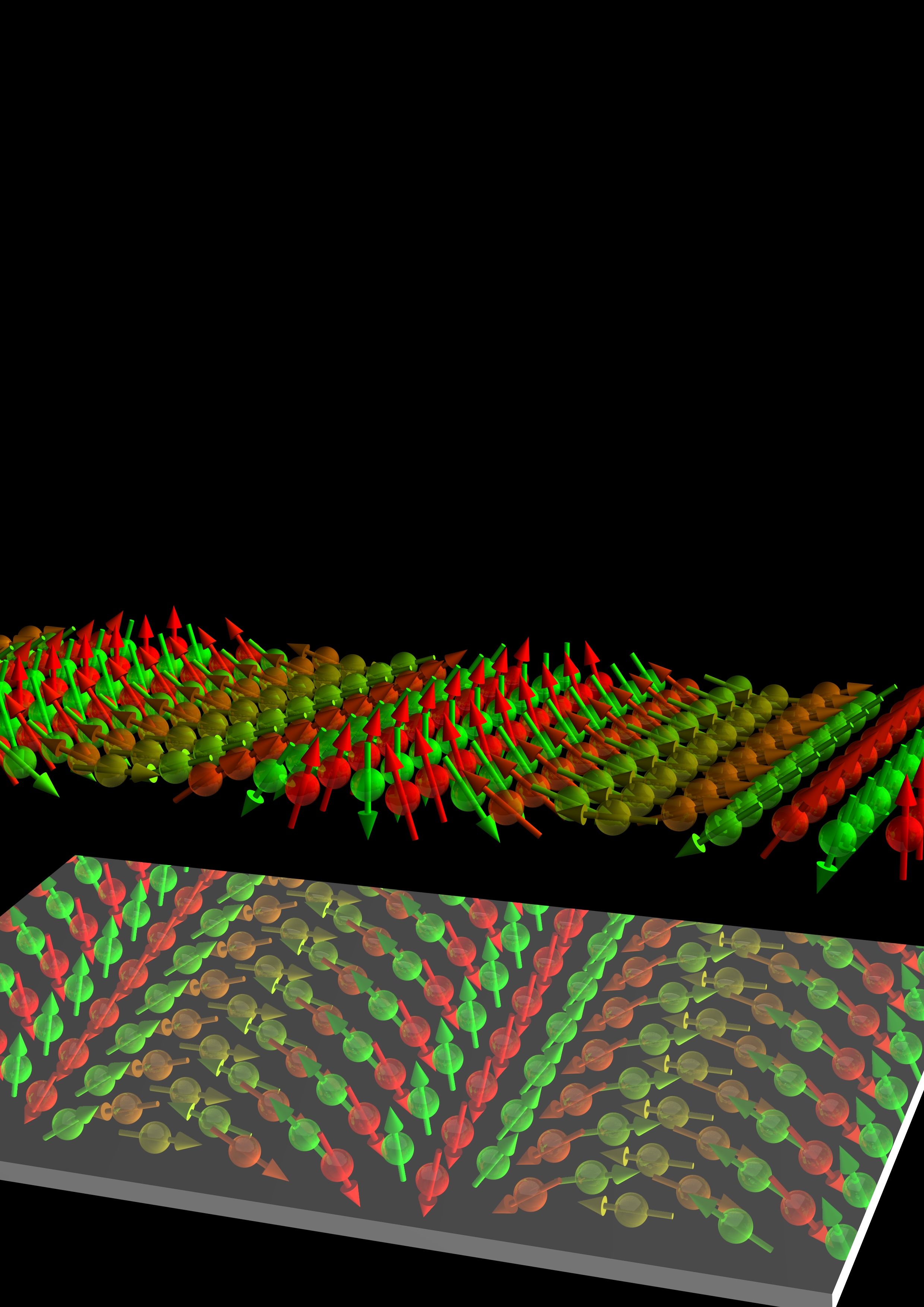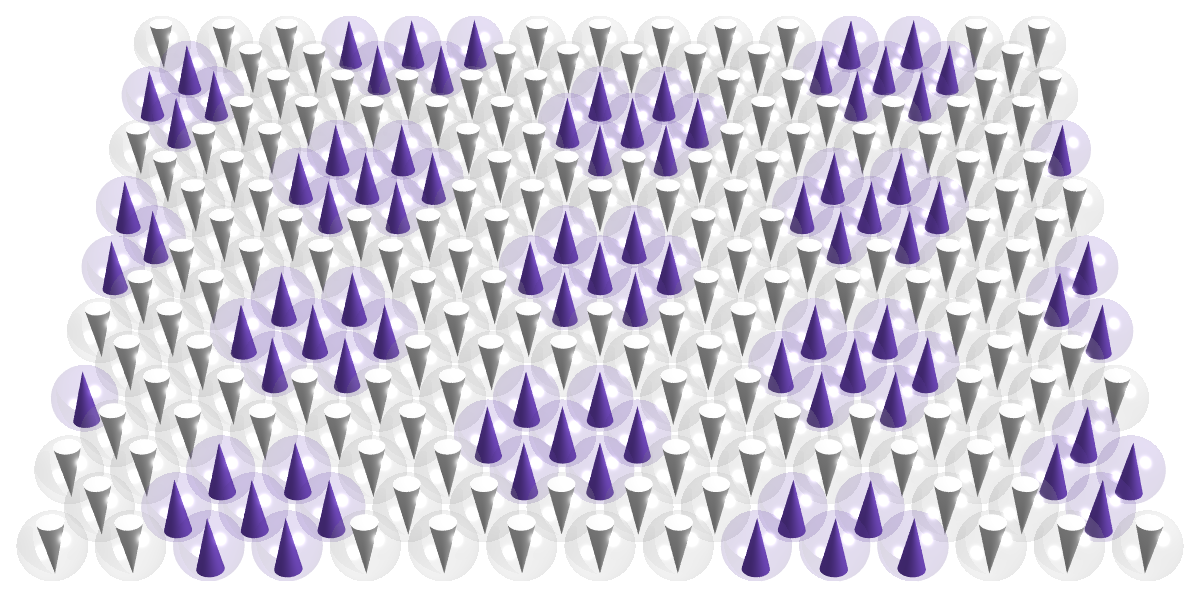Non-collinear spin structures at surfaces induced by the Dzyaloshinskii-Moriya interaction

Magnetism-based data storage technology relies on the fact that
information, i.e. the magnetic state of the area representing
the bits, is stable over time.
From the microscopic point of view, the direction of the magnetic
moments is stabilized mainly
by the spin-orbit interaction, which couples the spin to the crystal
lattice and is responsible for the occurrence of easy and hard
magnetization axes.
Based on this picture, the need for nanoscale magnetic devices
called scientists to the quest for high magnetic anisotropy materials.
However, with decreasing magnetic bit sizes the structural inversion
asymmetry of interfaces and surfaces comes into play.
A surprising consequence of this fact is that this symmetry breaking
in combination with spin-orbit coupling leads to the
Dzyaloshinskii-Moriya interaction (DMI) favoring non-collinear magnetic order.
Although the DMI, because of its relativistic nature,
is usually expected to be negligible compared to the non-relativistic
exchange interaction, we demonstrated
(Nature 447, 190 (2007))
based on a combination of
first-principles calculations and scanning tunneling microscopy
experiments that it is sufficiently strong to impose a nanoscale
left-rotating cycloidal spin spiral on the
otherwise antiferromagnetic Mn monolayer on W(110):
adjacent moments slightly deviate from the collinear
configuration by about 7 degrees, resulting in a
long-period spin spiral.
Click here for more information on the image.
A crucial issue is whether the DMI can destabilize
the ferromagnetic state that is the basis of state-of-the-art
magnetic technology.
As a model system of competing ferromagnetic exchange interaction
and DMI, we investigated
one monolayer Mn grown on a different surface orientation
of W, namely W(001).
First-principles calculations and scanning tunneling microscopy
revealed that the DMI is able to induce a cycloidal
magnetic state even on the atomic scale: the ground state is a
spin spiral with a period of about 2.2 nm, corresponding to a
36-degree angle between adjacent moments.
Mapping the calculation results on a model Hamiltonian
allows us to study the system on a larger scale by means of the
Monte Carlo method. We found that the fourfold symmetry of the
square surface lattice leads to intriguing nanoscale labyrinth
patterns.
(Phys. Rev. Lett. 101, 027201 (2008)).
The Dzyaloshinskii-Moriya interaction is also the origin of topological spin structures such as magnetic skyrmions. For more information on skyrmions
please look at our current research on "Topological spin structures".
One can also use non-collinear spin structures such as spin spirals to control the spin direction of single magnetic adatoms. In collaboration
with our experimental colleagues from the University of Hamburg, we have studied single Co atoms adsorbed on Mn/W(110).
Due to the strong exchange coupling between the Co adatom and the Mn monolayer the spin direction of the Co adatoms depends on its position
on the spin spiral state of Mn/W(110). Surprisingly, the spin state of the Co adatom can be read out by its appearance in the spin-polarized
STM image. Based on DFT calculations, it can be shown that this is due to the majority spin channel is dominated at the Fermi energy by
s states while d states are most important in the minority spin channel. This leads to the Co adatom appearing either as a circular shape, reflecting
the s-type orbital character, or as a two-lobe state due to the probed d-orbitals
(Nat. Nanotechn. 5, 350 (2010)). Because of the non-collinearity of the underlying
spin spiral state, the Co adatom displays non-collinear intra-atomic magnetism which explains the asymmetric shape of images if the Co spin is canted
with respect to the tip magnetization direction (PRB Rapid Comm. 98, 220401 (2018)).
Higher-order exchange interactions beyond the Heisenberg model
 The itinerant character of 3d transition-metals limits the applicability of the Heisenberg model to describe their magnetic
properties. Based on the Hubbard model it has been shown that higher-order exchange interactions beyond pair-wise Heisenberg
exchange can arise such as the biquadratic or the four spin interaction. Such higher-order terms can lead to intriguing
magnetic ground states due to a superposition of spin spirals - so-called multi-Q states - which have been predicted based on
first-principles calculations. Recently, we have discovered the occurrence of the triple-Q state in a Mn monolayer on
the Re(0001) surface in collaboration with our experimental colleagues
(PRL 124, 227203 (2020)).
The interplay of the four-site four spin interaction and DMI is the origin of the nanoskyrmion
lattice of the Fe monolayer on Ir(111)
(Nature Phys. 7, 713 (2011)).
We have further demonstrated that higher-order interactions can compete with the Dzyaloshinskii-Moriya
interaction (PRL 120, 207201 (2018)),
can play an important role for stability of isolated magnetic skyrmions
(Nat. Commun. 11, 4756 (2020))
and stabilize novel magnetic ground states
(Nat. Commun. 13, 5764 (2022)).
The itinerant character of 3d transition-metals limits the applicability of the Heisenberg model to describe their magnetic
properties. Based on the Hubbard model it has been shown that higher-order exchange interactions beyond pair-wise Heisenberg
exchange can arise such as the biquadratic or the four spin interaction. Such higher-order terms can lead to intriguing
magnetic ground states due to a superposition of spin spirals - so-called multi-Q states - which have been predicted based on
first-principles calculations. Recently, we have discovered the occurrence of the triple-Q state in a Mn monolayer on
the Re(0001) surface in collaboration with our experimental colleagues
(PRL 124, 227203 (2020)).
The interplay of the four-site four spin interaction and DMI is the origin of the nanoskyrmion
lattice of the Fe monolayer on Ir(111)
(Nature Phys. 7, 713 (2011)).
We have further demonstrated that higher-order interactions can compete with the Dzyaloshinskii-Moriya
interaction (PRL 120, 207201 (2018)),
can play an important role for stability of isolated magnetic skyrmions
(Nat. Commun. 11, 4756 (2020))
and stabilize novel magnetic ground states
(Nat. Commun. 13, 5764 (2022)).
If you are interested, more information can be found in the Publications,
Press releases and
Gallery Sections on this page. For further details you can
contact Stefan Heinze.
<<< Back to activities
 The itinerant character of 3d transition-metals limits the applicability of the Heisenberg model to describe their magnetic
properties. Based on the Hubbard model it has been shown that higher-order exchange interactions beyond pair-wise Heisenberg
exchange can arise such as the biquadratic or the four spin interaction. Such higher-order terms can lead to intriguing
magnetic ground states due to a superposition of spin spirals - so-called multi-Q states - which have been predicted based on
first-principles calculations. Recently, we have discovered the occurrence of the triple-Q state in a Mn monolayer on
the Re(0001) surface in collaboration with our experimental colleagues
(PRL 124, 227203 (2020)).
The interplay of the four-site four spin interaction and DMI is the origin of the nanoskyrmion
lattice of the Fe monolayer on Ir(111)
(Nature Phys. 7, 713 (2011)).
We have further demonstrated that higher-order interactions can compete with the Dzyaloshinskii-Moriya
interaction (PRL 120, 207201 (2018)),
can play an important role for stability of isolated magnetic skyrmions
(Nat. Commun. 11, 4756 (2020))
and stabilize novel magnetic ground states
(Nat. Commun. 13, 5764 (2022)).
The itinerant character of 3d transition-metals limits the applicability of the Heisenberg model to describe their magnetic
properties. Based on the Hubbard model it has been shown that higher-order exchange interactions beyond pair-wise Heisenberg
exchange can arise such as the biquadratic or the four spin interaction. Such higher-order terms can lead to intriguing
magnetic ground states due to a superposition of spin spirals - so-called multi-Q states - which have been predicted based on
first-principles calculations. Recently, we have discovered the occurrence of the triple-Q state in a Mn monolayer on
the Re(0001) surface in collaboration with our experimental colleagues
(PRL 124, 227203 (2020)).
The interplay of the four-site four spin interaction and DMI is the origin of the nanoskyrmion
lattice of the Fe monolayer on Ir(111)
(Nature Phys. 7, 713 (2011)).
We have further demonstrated that higher-order interactions can compete with the Dzyaloshinskii-Moriya
interaction (PRL 120, 207201 (2018)),
can play an important role for stability of isolated magnetic skyrmions
(Nat. Commun. 11, 4756 (2020))
and stabilize novel magnetic ground states
(Nat. Commun. 13, 5764 (2022)).
